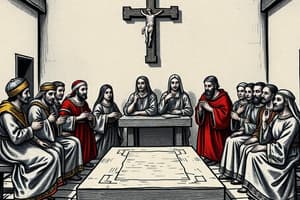Podcast
Questions and Answers
What was the name of the case associated with Raju Nand Kumar?
What was the name of the case associated with Raju Nand Kumar?
Raju Nand Kumar's case
What year was the Act of Settlement implemented?
What year was the Act of Settlement implemented?
1781
Who was the key figure responsible for judicial reforms during the period from 1787 to 1793?
Who was the key figure responsible for judicial reforms during the period from 1787 to 1793?
Lord Cornwallis
Between which years did the judicial reforms of Sir John Shore take place?
Between which years did the judicial reforms of Sir John Shore take place?
What was the year the Indian High Court Act was passed?
What was the year the Indian High Court Act was passed?
In what year was the Government of India Act enacted?
In what year was the Government of India Act enacted?
What was the name of the court established under the East India Company's charter?
What was the name of the court established under the East India Company's charter?
Which act was pivotal in establishing a legislature across India?
Which act was pivotal in establishing a legislature across India?
Which legal principle is often associated with the concept of 'Suppression of power'?
Which legal principle is often associated with the concept of 'Suppression of power'?
Name the court that was referred to as 'Munsiff Court'
Name the court that was referred to as 'Munsiff Court'
In what year was the first charter of the East India Company given?
In what year was the first charter of the East India Company given?
What is the term that describes the dual court system used in pre-British India?
What is the term that describes the dual court system used in pre-British India?
Which legal instrument is known as the 'Charter of 1600'?
Which legal instrument is known as the 'Charter of 1600'?
The Indian high court Act 1911 introduced the concept of amalgamation.
The Indian high court Act 1911 introduced the concept of amalgamation.
What is the term used to describe the principle of separation of power in a government?
What is the term used to describe the principle of separation of power in a government?
What is the term used for a legal document requesting the government to ensure a certain action?
What is the term used for a legal document requesting the government to ensure a certain action?
What is the historical event that led to establishment of a legislature in India?
What is the historical event that led to establishment of a legislature in India?
Flashcards
East India company's arrival in India
East India company's arrival in India
The East India Company established its presence in India in 1600, marking the beginning of British influence in the region.
Charter Act of 1773
Charter Act of 1773
The Charter Act of 1773 aimed to regulate the East India Company's administration and consolidate its power in India. It introduced the Supreme Court in Calcutta to oversee the company's judicial functions.
Regulating Act of 1773
Regulating Act of 1773
The Regulating Act of 1773 was a landmark legislation that aimed to reform the East India Company's administration in Bengal. It aimed to introduce accountability and improve governance.
The first charter of East India Company
The first charter of East India Company
Signup and view all the flashcards
Charteral System of Courts
Charteral System of Courts
Signup and view all the flashcards
Dual System of Government
Dual System of Government
Signup and view all the flashcards
Warren Hastings's System
Warren Hastings's System
Signup and view all the flashcards
Cornwallis Reforms
Cornwallis Reforms
Signup and view all the flashcards
1772, 1773, and 1774 Judicial Reforms
1772, 1773, and 1774 Judicial Reforms
Signup and view all the flashcards
1790, 1793 Reforms
1790, 1793 Reforms
Signup and view all the flashcards
1796, 1795, 1797 Reforms
1796, 1795, 1797 Reforms
Signup and view all the flashcards
1834 Reforms
1834 Reforms
Signup and view all the flashcards
1861 Reforms
1861 Reforms
Signup and view all the flashcards
1874 Reforms
1874 Reforms
Signup and view all the flashcards
1911 Reforms
1911 Reforms
Signup and view all the flashcards
1915 Reforms
1915 Reforms
Signup and view all the flashcards
1919 Reforms
1919 Reforms
Signup and view all the flashcards
1935 Reforms
1935 Reforms
Signup and view all the flashcards
Mayor’s Court in Madras and Bombay
Mayor’s Court in Madras and Bombay
Signup and view all the flashcards
Munsiff Court
Munsiff Court
Signup and view all the flashcards
Supreme Court in Calcutta
Supreme Court in Calcutta
Signup and view all the flashcards
Adalat
Adalat
Signup and view all the flashcards
Privy Council in British India
Privy Council in British India
Signup and view all the flashcards
Federalism in British India
Federalism in British India
Signup and view all the flashcards
Law in British India
Law in British India
Signup and view all the flashcards
Justice in British India
Justice in British India
Signup and view all the flashcards
Writs and 'mandamus' in British India
Writs and 'mandamus' in British India
Signup and view all the flashcards
Study Notes
Justice System in Presidency Towns
- Administration of justice in Surat, Calcutta, and Bombay, and Madras.
- The Adalat system and judicial reforms by Warren Hastings (1772, 1773, 1774).
- The structure and powers of the Supreme Court in Calcutta.
- Cases: Raja Nand Kumar, Patna, Cossijurah, Kamal ud Din.
Judicial Reforms and Systems
- Act of Settlement (1781) and Lord Cornwallis's reforms (1787, 1790, 1793).
- Progress of the Adalat system under Sir John Shore.
- Impact of the Indian High Court Act of 1861 on the existence of a dual judicial system.
- Tendencies in consolidating the judicial systems.
- High Court developments under the Government of India Act of 1911 and 1935.
Charter of 1600, East India Company and Privy Council
- Role of the East India Company under Queen Elizabeth's charter of 1600.
- Development of the rule of law and suppressing of power by the Privy Council.
- Changes and impact in the governing of India in 1773 & 1834.
- The Government of India Act of 1919 and 1935.
- Legal Reforms and the Law Commission (1834, 1861, 1919, 1935).
Legal System and Profession
- Ancient Indian legal practices and the organization of legal systems.
- Structure and organization of the legal profession under the 1874 charter.
- Legal reforms in British India.
Important Court Structures
- Mayor's court.
- Rule of law in legal systems.
- Art of settlement (1781)
- Justice/equity/good consensus
- Munsiff Courts
- East India company and jurisdiction in Supreme Court of Calcutta
- Dual judicial system
- Independent judicial system
- Charter of 1600
- Suppression of power
- Regulating act of 1773
- Writs of mandamus
- Federalism in the Indian administrative structures.
Studying That Suits You
Use AI to generate personalized quizzes and flashcards to suit your learning preferences.




